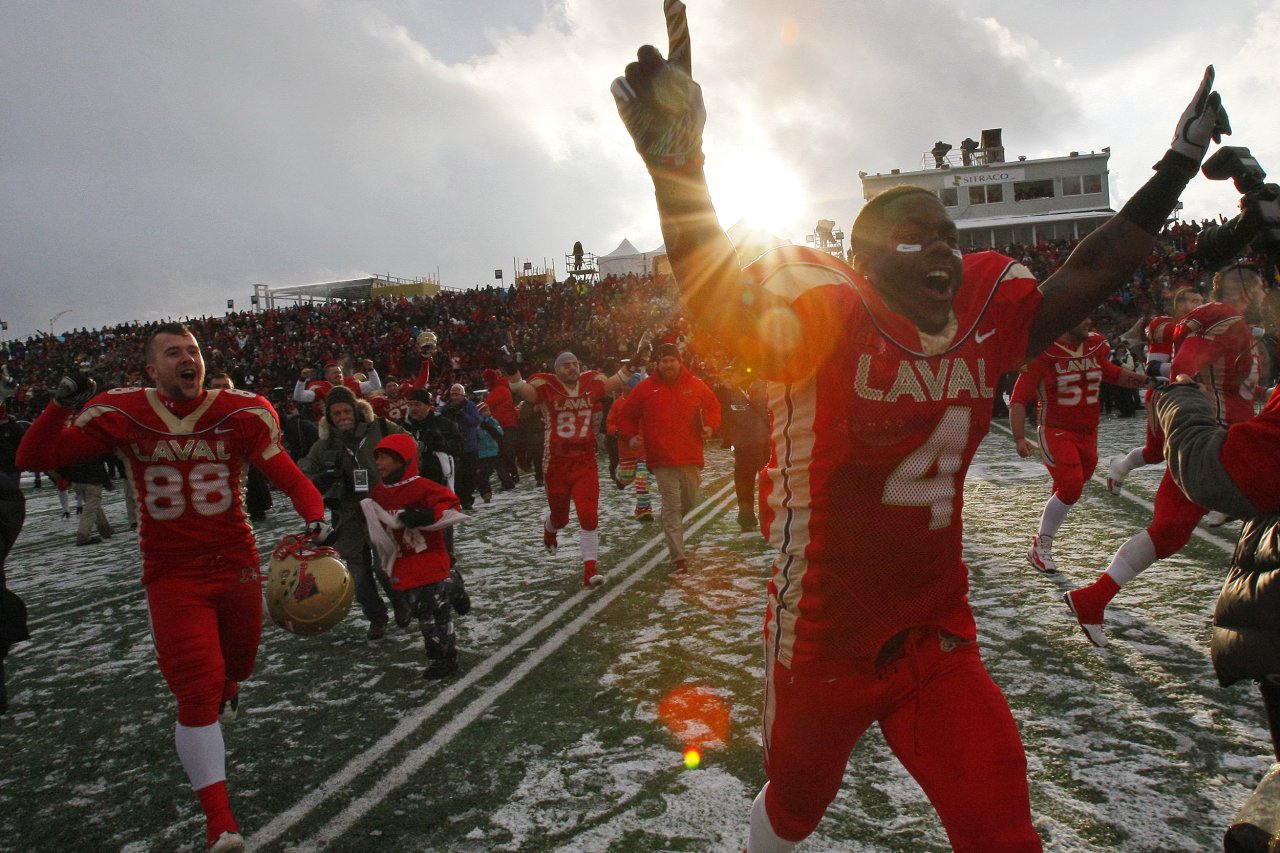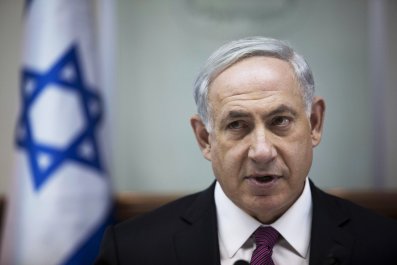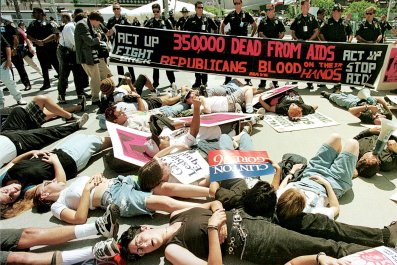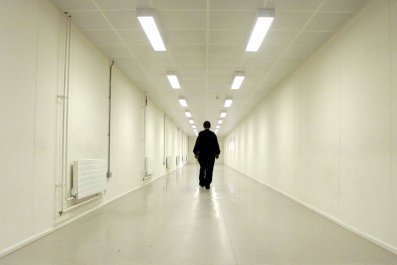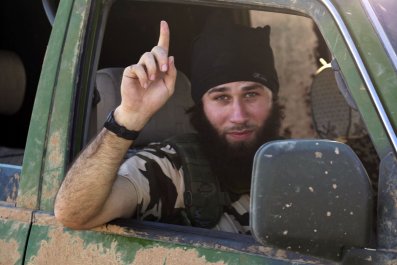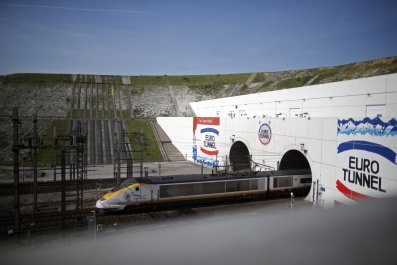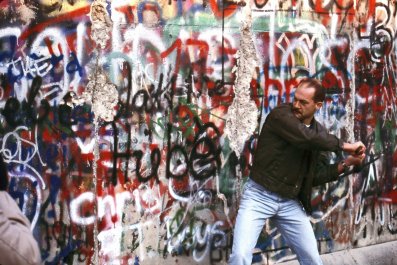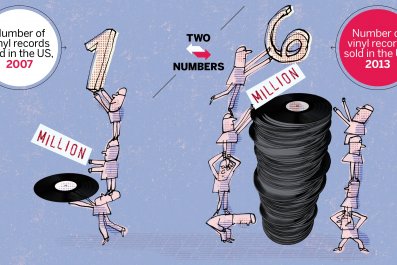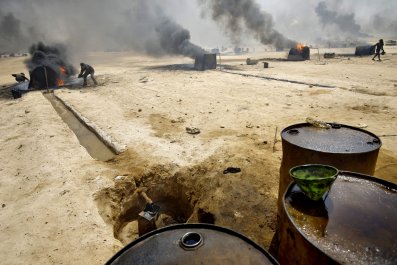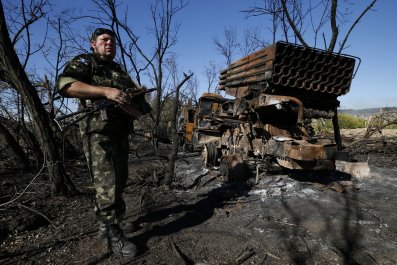The defending national champion in college football, the one with a win streak of some two dozen or so games, adorns itself in hues of red and gold—but it is not Florida State. It traces its origins and its French sobriquet to a Catholic priest who emigrated from France—but it is not Notre Dame. And its nouveau riche imprint on the sport may be traced back to a deep-pocketed alum who took it upon himself to jump-start the program in the 1990s—but it is not Oregon.
No—or should we say, non?—to all of the above. The most dominant team in college football in America—sorry, in North America—is Laval University of Quebec City, Quebec. On October 19 the Rouge et Or crushed Bishop's University, 64-3 ("Un Massacre!" blared a local daily) and five days later put together a 54-13 tour de force at McGill University in Montreal to move to 7-0 on the season. The latter victory was the 25th straight for the two-time defending national champions of Canada.
Last Saturday, however, Laval did lose 13-9 at the University of Montreal, a team it had beaten earlier in the season, 40-13. The defeat ended the Rouge et Or's two-plus year win streak but did not alter its playoff status.
Despite last Saturday's loss, Laval has still won 69 in a row on its home field, Stade Telus, located just a few kilometers north of the St. Lawrence River. This autumn Laval is seeking to win its third consecutive Vanier Cup (i.e., the Canadian national championship), and, having outscored opponents 386-74 thus far, the Rouge et Or are prohibitive favorites. Not bad for a football program that did not exist 20 years ago.
Since its inception in 1996, Laval football has become, pardon my French, the crème de la crème of Canadian Interuniversity Sport (CIS, a.k.a. the Canadian NCAA). This palindromic pigskin powerhouse has won eight Vanier Cups in its 18 seasons and 11 consecutive conference championships. They've had five undefeated seasons, which does not include 2003, when the Rouge et Or finished 7-1 but in consecutive games trampled Sherbrooke, 94-0, and Bishop's, 92-3. In that season's national semifinal, the Dunsmore Cup, Laval trounced Concordia 59-7. Quelle horreur!
"When I came here, I wanted to make Laval the capital of football in Canada," says head coach Glen Constantin, who signed on as defensive coordinator for Laval's inaugural season, 1996. That Constantin, promoted to head coach in 2001, has done so in the capital of French-speaking Canada, at a university where French is the official language, is no coincidence. The francophone-ness of Quebec City and Laval is this football program's raison d'être.
Bilingualism is a major domestic issue in the Great White North, where the majority of the country speaks English and images of British royalty still adorn the currency. Quebec, located just above New England, is the lone Canadian province where French remains the lingua franca. For Constantin, bilingualism is an even more intimate domestic issue: His mother was French and his father English.
"The reason that this team exists," says Constantin, whose career record is 97-16, "was to give kids an opportunity to play college football in their mother tongue. Quebec is sort of the Texas of Canadian high school football, and before our football program existed, kids here had to leave the province to play college football."
'They Don't Want to Lose Their Souls'
It is Sunday morning, roughly three hours prior to kickoff. In a lot just beyond the south end zone of Stade Telus, where parking is free, hundreds of fans tailgate. To the north, the open end of the 12,750-seat stadium offers a sweeping vista of the Laurentian Mountains. In the center of the 110-yard field, a singer rehearses "O Canada" in both English and French. Constantin, an amiable, ursine fellow just a month shy of his 50th birthday, sits in his football office. He is asked about the one season he spent in Division I football south of the border, in 1995, as a graduate assistant at the University of Houston.
Constantin grins and pulls up the blotter that rests atop his desk, then pries a color photo from beneath it. There he is, standing on a sun-splashed field at the Los Angeles Coliseum, the famed peristyle in the background. "It was awesome," Constantin says of his lone season on an American college football sideline. "My first game, we opened at Florida in 'The Swamp.' They were ranked No. 5, and we were, like, 106th."
Constantin, who aspired to coach in the NFL, was not the only Quebecois native heading south of the border in the mid-1990s. In 1995 the Quebec Nordiques of the National Hockey League broke the city's collective heart by emigrating to Denver to become the Colorado Avalanche.
As the city wallowed in ennui, a local physical education teacher named Mike Labadie noticed that while high school football was gaining in popularity in Quebec, none of the province's francophone universities offered it at the university level. French-speaking gridders had no option if they hoped to continue their careers, other than to matriculate at anglophone schools, mostly outside of Quebec. (Constantin played at the University of Ottawa.)
Enter Jacques Tanguay, a 32-year-old scion of one of Quebec's leading family-owned furniture companies. An avid sports fan, Tanguay threw his support and part of his fortune behind the creation of a football program at his alma mater. Tanguay, through an interpreter, noted the exodus of the Nordiques and the dearth of a francophone football program as reasons for him to invest in Labadie's concept, but there was another. "I am much closer to the decision making in amateur sports," he says. "If I were the owner of a professional sports team, I would not be as involved."
That's correct. It may seem an avant-garde idea to the sanctimonious NCAA, but in Canada there is no rule against intercollegiate athletic programs being completely funded and overseen by private enterprise. Tanguay is the de facto Jerry Jones of Laval football—it was Tanguay, and not the school's athletic director, who fired Constantin's predecessor, Jacques Chapdelaine, in 2000. Each week, Tanguay meets informally with three other board members who oversee the Rouge et Or. While they make no decisions in terms of players or what transpires on the field, Tanguay oversees the budget and nearly all other matters, A to zed. In fact, every intercollegiate sport at Laval has its own private board of directors that oversees finances and operations. It's all so....provincial.
When I ask Gilles Lepine, Laval's gregarious and dashing athletic director, why more schools in Canada do not adopt Laval's model, he smiles. "They don't want to lose their souls," he says. "At least that's what they tell me."
Nike founder and Oregon alumnus Phil Knight has donated more than $100 million to his alma mater's athletic department. Isn't it—what's the French term?—naïve of us Yanks to believe Knight is not involved in how that department operates? Laval University's rector (president), Denis Brière, thinks so, which is why he has no problem with Tanguay being his football program's general manager. "When you know the beast you're dealing with," says Brière with an air of nonchalance, "it's OK."
Tanguay also finds the NCAA's separation of private enterprise and intercollegiate athletics—in word if not deed—a farce (Under Armour, for example, recently entered into at 10-year, $90 million licensing deal with Notre Dame). When told that it would be a punishable violation for Tanguay, a millionaire, to buy lunch for Laval quarterback Hugo Richard if the Rouge et Or were an NCAA member school, he laughs. "If those rules were really applied in the States," Tanguay says, "then there would be no college football in the States."
The Imperialist Coach
There are three big reasons for Laval's hegemony in the CIS. The first is capital. When asked if money motivated him to launch the football program, Tanguay quips sardonically, "Spending money!" The Rouge et Or were the first CIS football program to have full-time, paid assistant coaches and the first to use video editing. Each spring break, the entire team buses to Orlando, Florida, for a week of spring training, and if you don't appreciate what a perk that is to a Quebecois youth, you've never spent a winter in Quebec.
"The program has enough money to fly us all down," says the star of last year's team, Guillaume Rioux, who now plays professionally in Germany, "but we take the buses to build team unity."
The second reason is an educational wrinkle, unique to Quebec, that gives all universities in this province a huge advantage. In longhand, it is College d'enseignment general et professionel, but all in Quebec refer to it simply as CEGEP: a mandatory two- to three-year educational bridge between high school and university. The closest American analog to CEGEP is junior college, except that in Quebec everyone attends CEGEP. While high school in Quebec ends at the American equivalent of junior year, it still means that Laval is welcoming freshmen who are two to three years older than players at universities in Canada's other provinces.
"That's true," says Lepine, the athletic director, "and it may give us an advantage against schools from Ontario or the West. But every school in our conference is also from Quebec, and we've won the conference 11 years in a row."
That's due to the third reason: Constantin, who shares many an imperialist trait with his historical namesake. At the beginning of each summer, Laval hosts a Quebec-wide high school All-Star Game, which is the equivalent of a weeklong campus visit for the province's top players before they head off to CEGEP. At the end of each summer, Laval hosts a preseason exhibition game, more often than not against a university from western Canada that Constantin envisions Laval meeting in the national semifinal or the Vanier Cup. This August it was the University of Calgary, currently No. 2 behind Laval in the national rankings.
"It's an opportunity to play some stiffer competition," says Constantin, noting that Laval paid all of Calgary's travel expenses, "and yes, it's a chance to scout them."
Success breeds success. One-third of the head coaches in the 50 or so CEGEP schools played under Constantin. And while Constantin works hard—he attended a pair of CEGEP games in Montreal on the eve of today's game—the program's cachet sells itself to recruits, who receive tuition (approximately $5,000 per year) but not room and board.
"When I was growing up, I wanted to be a professional hockey player," says 6-foot-6, 325-pound left tackle Danny Groulx. "But as I kept growing, football became the better choice. And when you grow up playing football in Quebec, then playing for Laval is your dream."
A Window of Immunity
Back inside Stade Telus, the Rouge et Or lead Bishop's 7-0 in the first quarter. The ball is on Laval's seven-yard line when Richard drops back to pass. He spots Maxime Boutin, whose position is technically porteur de ballon (ball carrier), in the left flat. Boutin races untouched up the left sideline to the 20, past the 30, the 40, the 50, the 55!—a writer in the press box sighs, "Bonsoir." It is a 103-yard touchdown (a "touche") for Boutin, something that is technically impossible in American football.
While no Canadian, not even in Quebec, would claim that football supersedes hockey, Canucks are fiercely proud of their gridiron lineage. They will eagerly yet politely inform you that the first documented football match took place at the University of Toronto in 1861, eight years before the first American football game, between Princeton and Rutgers.
Canadian football is, like Canadian spelling ("defence"), similar but not identical to American football. Besides the longer field—and end zones that are 20 yards deep—there are only three downs. Referees toss orange, not yellow, flags. The fair catch is not an option, but the punt team must give the receiver a five-yard window of "immunity." And there is something called a "Rouge Point," awarded to a team if the opposing side fails to return any kicked ball (kickoff, field goal or punt) that lands in the end zone beyond the goal line…which demystifies a final score from earlier this season: Laval 43, Sherbrooke 1.
The similarities between CIS football and the Saturday circus in the U.S. are numerous. The Hec Crighton Trophy, named after a former teacher, coach and referee, is analogous to the Heisman Trophy. There are Golden Bears (University of Alberta) and Gaiters (Bishop's). There is a weekly highlight show, Krown Countdown U., that resembles what would happen if ESPN's College GameDay mated with SCTV's Bob and Doug McKenzie. During a recent highlights package, co-host Ryan Sullivan quipped of a player who ran back a punt for a touchdown (1:58 mark), "He is gone, like a bullet that was shot out of a gun that shoots bullets."
And while American college football die-hards are patting one another on the back over the formation this season of a four-team playoff, the Vanier Cup—a national four-team playoff—is celebrating its 50th anniversary. (You're welcome, America?)
There are differences, though. In CIS football, both teams' benches are on the same sideline, with each extending to the 45-yard line. The origin of that tradition dates back to 2005 and a melee involving the Rouge et Or and the University of Montreal. "They stomped on our logo at midfield during pregame introductions, and it incited a huge row," says Laval's chargé de communication, Stéphane Jobin, "so no player is permitted to cross the 45-yard line unless he is coming in or out of the game."
Hitting With Empathy
Back at Stade Telus, the sun fades behind the western stands, and a chill descends upon half of the stadium's 13,392 attendees (no other Canadian school draws even half as many fans). Richard, a freshman who has a trebuchet for an arm, has just thrown his seventh touchdown pass. He took over the starter's role when the incumbent quarterback, Alex Skinner, was suspended for three games for his part in a bar brawl last spring. (The starting quarterback of the defending national champion involved in an off-field criminal incident?!)
Laval leads 61-3. Now it is late in the third quarter. As the Rouge et Or line up for the PAT, the scoreboard clock continues to run. As it will throughout the fourth quarter, regardless of incomplete passes or out-of-bounds plays or changes in possession. Is this yet another Canadian football wrinkle? A merci rule?
"Not exactly," Jobin, Laval's sports information director, will explain later. "It's just that the coach at Bishop's asked Glen [Constantin] to do it because he has so many guys banged up. And Glen agreed."
One day earlier, Alabama beat Texas A&M 59-0, and no such plea was made. But that's the mark of the most dominant college football team in in the Western Hemisphere: At Laval, even empathy isde rigueur.
Corrections: This article mistated the year Nordiques left Quebec City, it was 1995, not 1994. The article also mispelled Gilles Lepine and gave Alex Skinner's name incorrectly. It also misstated when Laval played Concordia, it was at the Dunsmore Cup. Also, this article stated Laval has the longest winning record in college football, it is actually North Dakota State.



